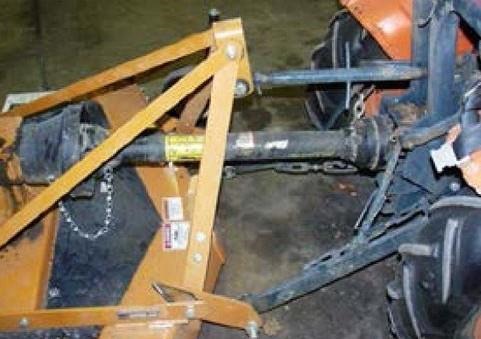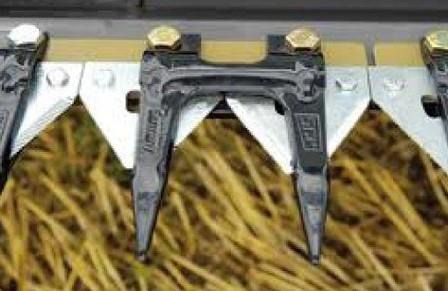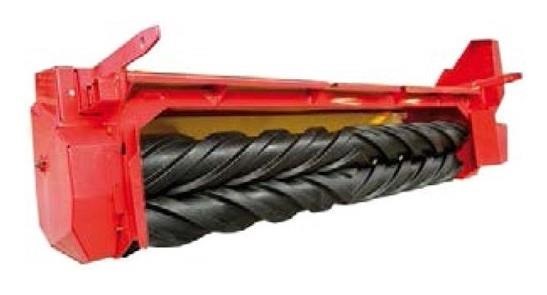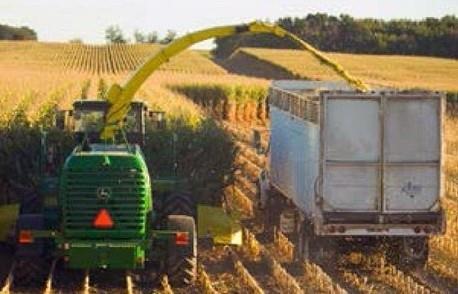By Dennis Murphy
Forage harvesting begins with the cutting of fresh forages. This task can be accomplished by a mower, mower-conditioner, or windrower. Safety precautions related to these machines can best be discussed by identifying the four major hazard areas including the power take-off (PTO), cutter bar or swinging knives, crimping or crushing rolls, and gathering reels.
Power Take-Off
Mowers and mower-conditioners are typically powered by a PTO which transfers power from the tractor. The PTO and drive shaft can rotate 9 times/second (540 rpm) or 16.6 times/second (1,000 rpm) when operated at full recommended speed. Most PTO incidents are entanglement incidents. Keeping the tractor's master shield and the machine's PTO driveline shield in place and in good operating condition is the first line of defense. In regards to forage harvesting, many old sickle bar mowers have unguarded PTO shafts with little or no shielding of their rotating or moving parts. Reduce your risk of an entanglement incident by always disengaging the PTO, shutting down the tractor, and removing the keys from the ignition before getting off of the tractor. Always walk around the tractor and never stand near or step over a rotating PTO shaft.

Cutter Bar
Cutter bar incidents typically result in severe lacerations or amputations, particularly to the fingers and toes. These incidents occur when the cutter bar plugs up in the field or during maintenance or servicing. To safely unplug the cutter bar follow these steps:
- Stop and disengage the PTO;
- Raise the cutter bar and back up a few feet to be at a safe distance;
- Shut off the tractor, shift into park or engage the parking brake;
- Remove the keys from the ignition, and
- Pull hay or other material away from the cutter bar while wearing leather or synthetic gloves.
Once you have removed the clogged area, check the cutter bar for broken guards or knife sections before starting the engine and engaging the PTO at low speed. Lower the cutter bar, ease mower into standing crop and resume operation. If a knife section needs to be replaced, always handle the blade bar from the rear side. If possible, remove the sickle bar by yourself. Numerous injuries have occurred when two people did not adequately coordinate their movements.

Crimping and Crushing Rolls
Conditioners and mower-conditioners use crimping or crushing rolls to condition hay so it dries more quickly. The photo below is an example of crimping rolls. These rolls are PTO-powered and pull the hay between the crushing rollers and throw it out of the back of the machine. Small stones, pieces of metal, or wire can be picked up and hurled backward with enough force to penetrate the skin or eye, so never allow anyone to walk behind or near the machine during operation. Also, avoid reaching into the front of the crimping rolls to brush away plugs or debris because a hand and arm could easily be pulled between the crimping rolls before you even realize you are caught in the machine.

Gathering Reels
Reels and tines are an additional hazard on some conditioners and mower-conditioners. The reels help deliver the crop to the crimping rolls. Operators have been hit in the head by rotating reels as they bend over either in front of or behind the reel to clear plugs. Operators have also been pulled into the reel where tines have caught hands or clothing. The obvious way to avoid these injuries is to disengage the PTO, turn off the tractor or self-propelled machine, and make sure all movement has completely stopped before cleaning or servicing the machine.
Raking Hazards
Depending on the type of machine, the crop may or may not be left in a windrow. If the crop is not in a windrow, then it will need to be raked. Rakes are not particularly hazardous because they are not operating unless the operator is on the tractor and moving down the field. However, fatal and other serious injuries occasionally occur because operators or extra riders fall off the tractor and are run over by either the tractor and/or the rake. Hay fields are likely spots for groundhog holes and the jarring action they cause when a wheel drops into a hole causing the operator to potentially lose control of the tractor and be thrown from the seat. Avoid these types of incidents by refusing to carry extra riders, visual inspection of the field before field operation, and use a tractor equipped with a ROPS and wear the tractor's seat belt. If you are unable to go around a groundhog hole, simply shift to a lower gear and ease the tractor over the hole.
Self-Propelled Windrowers
Self-propelled windrowers mow, condition, and windrow hay in one trip over the field. The speed at which you operate your windrower can play a large role in preventing an incident. The frequency of plugging can increase if you are going too fast. The more frequently you have to unplug your machine, the higher the chances of an incident. Matching your machine's speed to the crop condition and the terrain will generally save you time and reduce risk of injury. Besides, frequent stops to clear the machine usually consume more time than steady harvesting at a slower speed.
Forage Chopping Machines
Forage chopping machines have numerous mechanical hazards, such as rotating shafts, gears, chains, and belts. Perhaps the most important thing for forage harvester operators to remember is that their machine is designed to gather in the crop and chop it into fine pieces so that it can be blown into a trailing wagon or dump truck. Therefore this machine uses sharp knives operating at high speeds. If your arm or leg is drawn into the machine, it will be treated exactly as if it were a stock of corn or a swath of hay.
Most forage harvesters have a built-in knife sharpener. However, some sharpeners require shields to be removed in order to operate. When completing this task, always wear eye protection and keep your hands, arms, and head away from the opening. If you must repair or replace knives, block the cylinder cutter head so it does not move unexpectedly. Because the knives are freewheeling and continue to rotate after the power has been shut off, it is very important to wait until all rotating parts (e.g., rotors and blades) have come to a complete stop. Never insert anything (e.g., sticks, broom handles, etc.) into the knives to bring them to a quick stop. If you try to stop a freewheeling part from rotating, not only can your hands be jerked into the knives by this practice, but debris can be thrown back at you.
Transporting Your Crop
If you have safely harvested your crop from the field, transporting it back to the farmstead is no time to let your guard down. Make sure that the tractor or dump truck you are using is large enough to handle the weight of the load on hills, that the tractor or dump truck brakes are in good condition and properly adjusted, and the tractor or dump truck operator has enough experience to operate a tractor or dump truck with a heavy load on public roadways. Remember to double check to make sure you are using the proper sized safety drawbar pins.

If you must haul a heavy load on public roadways, attach a safety chain between the tractor and the wagon. A slow-moving-vehicle (SMV) emblem is required, by Pennsylvania law, to be placed on the back of the trailing equipment. Replace any SMV emblems that are faded or damaged. Additional reflective marking is recommended on the back of the wagon to alert approaching motorists of your presence. Red retroreflective and red-orange fluorescent tape strategically located on the rear of your wagon and yellow retroreflective tape on the front of your wagon can increase the visibility to motorists. If your tractor has flashing lights, use them, and also use hand signals as appropriate. In many cases, it may be necessary to arrange for another vehicle to follow the tractor operator while on a public roadway. This type of escort is a particularly good idea during times of poor visibility, with less experienced tractor operators, or when you are hauling two wagons. Plan your day so that you can stay off roadways after dusk.
Summary
From field to the barn or silo, forage harvest includes hazards from A to Z. Field conditions, mechanical hazards, operator skill, and transportation over public roadways demand that full attention to the situations that can cause injury or death be observed. Harvest time brings with it a times of quick actions. Don't let haste ruin a rewarding time of the year.
Source : psu.edu